Abstract
A new species of Ledebouria is described and illustrated from near Greyton in the Western Cape of South Africa. It consists of dense clusters of plants, bearing semi-succulent linear-elliptic to linear-ovate leaves that are appressed to the ground, and with 12 distinct pale whitish green ridges with glandular hairs. Ledebouria weberi is morphologically similar to Ledebouria corrugata in having lines of papillae on the adaxial lamina surface, and soil particles adhering to the leaf surfaces. However, L. weberi is distinguished from L. corrugata in having only 12 rows of ridges with three-lobed tongue-shaped trichomes vs 30–40 broken rows with obtuse papillae, a flaccid inflorescence vs an erect inflorescence, longer peduncle and pedicel, smaller tepals, longer stamens and smaller ovary. Ledebouria weberi is known from several gatherings made by Wolfgang Weber since 2000. Plants grow in full sun on lateritic gravel flats.

